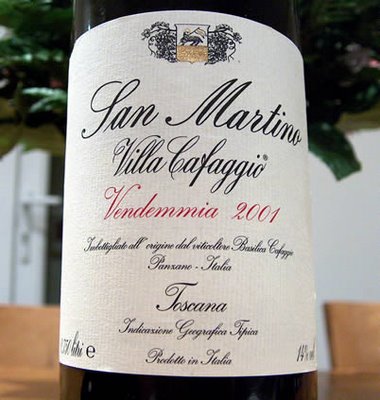Torres and Tuscany

Had a tasting, lunch and lots of tecchie chat with Mireia Torres, daughter of Miguel and technical director for all Torres' wines. We began by tasting all the Torres Chilean wines, and then lunched at La Trompette in Chiswick, which performed very well, getting my two dishes just right. I'm quite a fan of the Torres wines: their strength is that they do commercial winemaking very, very well, and their higher end wines aren't bad either. As an example, with lunch we had Grans Muralles 1998, and it was singing: evolved but still very fresh, bright and focused. And their two top Chilean wines - the spicy Carignan-dominated Cordilleira 2005 and the lush Conde de Superunda 2000 with Tempranillo, Cabernet, Mourvedre and Carmenere - rank among the very best that Chile has to offer. I also like the Marimar Torres wines from California.
Switching from Torres to Tuscany, I'm drinking a wine I can't make my mind up about, but which I think I like.
 Villa Cafaggio San Martino 2001 IGT Toscana
Villa Cafaggio San Martino 2001 IGT ToscanaThis is a wine I'm enjoying quite a bit, but which leaves me unsure about whether it's truly serious or not. It's a wine made from different clones of Sangiovese in Chianti (so why is it an IGT Toscana?), aged in new small oak barrels. Weighing in at 14% alcohol this is quite deep coloured. It has a fresh, bright nose that's more red fruit than black, with some lifted spice complementing the tight fruit. The palate is mouthfilling, tannic and quite extracted, dominating by bright red fruits with a vivid spicy, grippy character that leaves the mouth feeling quite dry. There's certainly a lot going on here: I really like the freshness of fruit, I appreciate the savouriness, but I struggle a bit with the rather agressive spiciness, some of which I suspect has its origin in the new oak. Is this wine overextracted and lacking in elegance? Will the dry tannins outlive the fruit? Or is it a serious wine caught early in its youth? I like the fact that it's not soupy and overripe, so I'm going to give it the benefit of the doubt. Very good/excellent 93/100 (c. £23 Waitrose, D Byrne, Sandhams, Upton on Severn Wines, Satchells, Wine Times, Wright Wine)
Labels: Chianti, Italy, spain, torres, wine science


4 Comments:
The Villa Cafaggio is very much a new wave style of Sangiovese and I'm afraid I don't see the point of it. In attaining richness and density much of the delicacy, freshness and charm of the grape is lost. For starters the grapes are harvested late with low yields. There is a lot of extraction; long macerations; micro-oxygenation; malolactic in new French barriques and ageing for 18 months in new French barriques, in other words the whole box of winemaker's tricks achieving the effect of what Shakespeare memorably phrased as "throwing perfume on a violet". From the colour you might think it would come from anywhere except Italy. Another example of a wine that is technically fine, but hard work (even boring) to drink and lacking soul. And no wonder the price is £23 with the amount of new oak that is used.
Doug
Your views help me crystallize my thoughts a bit. In short: I think the better side of me agrees with you. It is over-extracted, and tricked up. That the result is still quite fresh and vibrant, albeit it a bit harsh and forward, I guess testifies to the resilience of Sangiovese and the benefits of the terroir it comes from. I worry I have been too kind on this wine; still, I prefer it to a soupy Aussie or a 98-point right banker.
The Italian disease seems to be that they herd towards this sort of winemaking approach, as we discussed with the consultant winemaker thred. One of the wines you showed me a couple of weeks ago was a revelation: it was Chianti expressing elegance and interest, without being lacking in the flavour department. Why isn't it done more often? It seems that it's done hardly at all, especially in Tuscany.
Hi Jamie,
Yes, it's an interesting point. In Italy (driven by Tuscany, a sort of proto-Bordeaux) there seems to be the cult of the oenologist. The Sangiovese which is a beautiful, expressive, elegant grape has been yoked into marriage with Cabernet, Merlot and Syrah, picked later to avoid the herbal, medicinal edge that gives it character and finally swamped in new oak. This is all done because of the perception of universal excellence; these are the wines that invariably receive awards (such as Cotarella's), therefore these are the wines are that now considered "benchmark". The aspiration to excellence has the simulataneous effect of neutralising the individuality of the wine because it seeks to impose identity than reflect typicity. The Chianti Classico Le Trame from Podere Le Trame that we tasted the other week is the philosophical opposite. It celebrates the beauty of the Sangiovese variety (beauty does not need make up or, in this case, new oak barrels) and links it to its autochthonous partners; it is about expressing the purity of flavour and the nature of the vintage, for better or for worse. The grower makes one wine - not a vast range of Tuscans, Super Tuscans and Soupy Souped-Up Super Tuscans. I tasted not at that long ago a 1960 Chianti from Castello di Bossi, an estate which churns out very-well made smoothly oaked numbers. The simple Chianti was wild, it reared up and barked for attention. It was more palpably real than its modern equivalents. The interventionist approach starts from the premise that "we have all this technology at our disposal, we might as well use it". I worry that certain Italian winemakers don't understand why they do things; they have a vague idea about putting together lots of great elements without thinking of the whole. Reminds me of the galactico approach of a certain underperforming Real Madrid, a team less than the sum of its flashy parts.
Did you try the Mas la Plana Cabernet Sauvignon 2002, Jamie? I tasted it in January from Torres in Penedes, and I have never written such jumbled and contradictory tasting notes about any wine.
On Chianti, a wine merchant I spoke to in Florence said that he was actively diverting the attention of his clients from Sangiovese with a dollop of international varietals to pure Sangiovese Chiantis. I brought one of each - a Castello di Ama Chianti Classico 2004 (80% Sangiovese with a healthy dollop of Merlot) and a San Giusto a Rentenanno Riserva (97% Sangiovese 3% Canaiolo). It will be interesting to taste both in light of the merchant and Doug and Jamie's comments.
Post a Comment
Links to this post:
Create a Link
<< Home